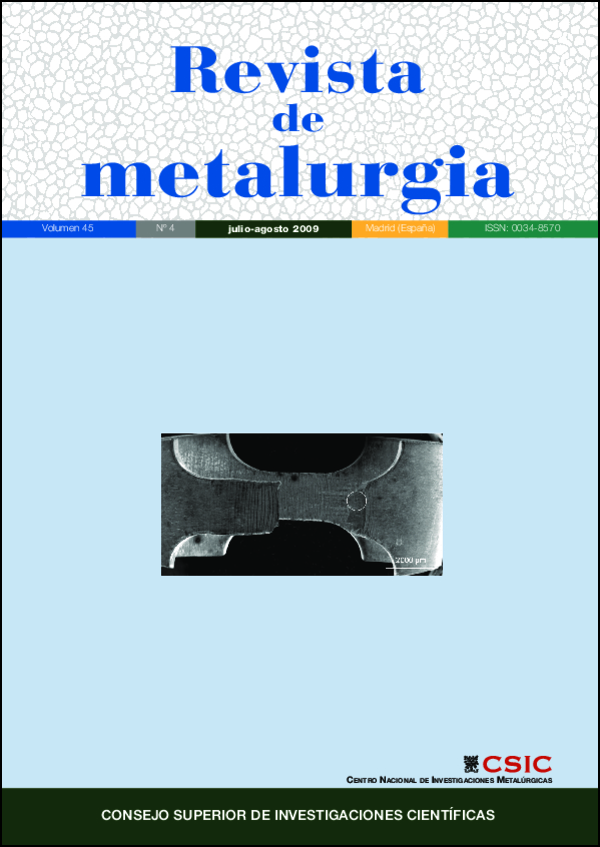Solid-fluid characteristics at the blast furnace hearth according to the nodal wear model (NWM)
DOI:
https://doi.org/10.3989/revmetalm.0836Keywords:
Blast furnace, Hearth, Lining corrosion, Porosity of dead coke (dead man)Abstract
The coke porosity is one of the most important variables that can affect the pig iron production and the lining corrosion. Up to now, the existing bibliography about lining corrosion always connects a deeper wear to an increase in the fluid flow (pig iron) at the blast furnace hearth. However, there is no evidence of any deterministic model that could link, from the theoretical point of view, the following variables: lining corrosion, porosity of dead coke and flow of pig iron at the hearth. Besides justifying the lining corrosion profiles, the Nodal Wear Model (NWM) can be an effective instrument to interpret the coke porosity and the pig iron speed rates that are generated inside the hearth.
Downloads
References
[1] J.P. Bennett y J.D. Smith, Fundamentals of Refractory Technology: Corrosion of Industrial Refractories, American Ceramic Society, Ceramic Transactions, Vol. 125, Ohio, EE. UU., 2001, pp.135-154.
[2] M.A. Romero, J. Jimenez, J. Mochón, J.L. Menéndez, A. Formoso y F. Bueno, Rev. Metal. Madrid 36 (2000) 40-46.
[3] R. Parra, L.F. Verdeja, M.F. Barbés, Ch. Goñi y V. Bazán, JOM 57 (2005) 29-36. doi:10.1007/s11837-005-0148-4
[4] Ch. Goñi, M.F. Barbés, V. Bazán, E. Brandaleze, R. Parra y L.F. Verdeja, J. Ceram. Soc. Jpn, 114 (2006) 665-668. doi:10.2109/jcersj.114.665
[5] U. Janhsen, E. Faraji, J.O. Wikström, O. Kerkkonen, P. Arendt y A. Babich, . Technical Steel Research. EUR 22439 EN, Bruselas, 2007.
[6] V. Panjokovic, J.S. Truelove y P. Zulli, Ironmak. Steelmak. 29 (2002) 390-400. doi:10.1179/030192302225005187
[7] H.B. Lu.ngen, H.P. Ru.ther, G. Clixby y G. Cassella, Technical Steel Research. EUR 19347 EN, Bruselas, 2000.
[8] K. Mu.lheims, W.D.N. Pritchard, J.M. Steiler y M. Schulte, Technical Steel Research. EUR 20109 EN, Bruselas, 2002.
[9] L.F. Verdeja, J.P. Sancho y A. Ballester, Materiales Refractarios y Cerámicos, Ed. Síntesis, Madrid, España, 2008, pp. 156-176.
[10] M.F. Barbés, E. Marinas, E. Brandaleze, R. Parra, L.F. Verdeja, G.A. Castillo y R. Colás, ISIJ Int. 48 (2008) 134-140. doi:10.2355/isijinternational.48.134
[11] S.A. Zäimi, M.J. Venturini y D. Sert, Rev. Metall. Paris 99 (2002) 18-19.
[12] U. Janhsen, A. Gu.nbati, C. Sautner, E. Faraji, J.O. Wikström, T. Hilding, E. Eriksson, O. Kerkkonen, P. Arendt y A. Babich, Technical Steel Research. EUR 22439 EN, Bruselas, 2007.
[13] O. Havelange, G. Danloy y C. Franssen, Rev. Metall Paris 101 (2004) 195-201. doi:10.1051/metal:2004101
[14] O. Havelange, G. Danloy, J.M. Venturini, H. Pierret, H-P. Ru.ther, O. Mielenz, H. Köchner; J.A. Alexander, J.R. Post y G. Clixby, Technical Steel Research. EUR 20942 EN, Bruselas, 2004.
[15] G. Danloy, M. Falzetti, A. Formoso, E. Herfurth, E. y J. Vega, Technical Steel Research. EUR 20094 EN/DE, Bruselas, 2002.
[16] C. B. Alcock, Principles of pyrometallurgy. Ed. Academic Press, Londres, England, 1976, pp. 98-99.
[17] J.P. Sancho, L. F. Verdeja y A. Ballester, Metalurgia Extractiva: Procesos de Obtención, Ed. Síntesis, Madrid, España, 2000, pp. 100-103.
[18] Y. Kawai y Y. Shiraishi, Handbook of physicochemical properties at high temperatures, Ed. Iron and Steel Institute of Japan, Tokyo, Japón, 1988.
[19] I. Barin y O. Knacke, Thermochemical properties of inorganic substances. Ed. Springer-Verlag, Berlin, Alemania, 1973.
[20] D. Springorum, Slag Atlas, Ed. Verein Deutscher Eisenhüttenleute (VDEh), Du.sseldorf, Alemania, 1995.
[21] A. Ballester, L.F. Verdeja y J.P. Sancho, Metalurgia Extractiva: Fundamentos, Ed. Síntesis, Madrid, España, 2000, pp. 235-238.
[22] D.R. Poirier y G.H. Geiger, Transport phenomena in materials processing, Ed. TMS, Pennsylvania, EE. UU., 1994, pp. 93-98.
[23] J. Jimenez, J. Mochon y J. Sainz De Ayala, ISIJInt. 44 (2004) 518-526. doi:10.2355/isijinternational.44.518
Downloads
Published
How to Cite
Issue
Section
License
Copyright (c) 2009 Consejo Superior de Investigaciones Científicas (CSIC)

This work is licensed under a Creative Commons Attribution 4.0 International License.
© CSIC. Manuscripts published in both the printed and online versions of this Journal are the property of Consejo Superior de Investigaciones Científicas, and quoting this source is a requirement for any partial or full reproduction.All contents of this electronic edition, except where otherwise noted, are distributed under a “Creative Commons Attribution 4.0 International” (CC BY 4.0) License. You may read here the basic information and the legal text of the license. The indication of the CC BY 4.0 License must be expressly stated in this way when necessary.
Self-archiving in repositories, personal webpages or similar, of any version other than the published by the Editor, is not allowed.
















